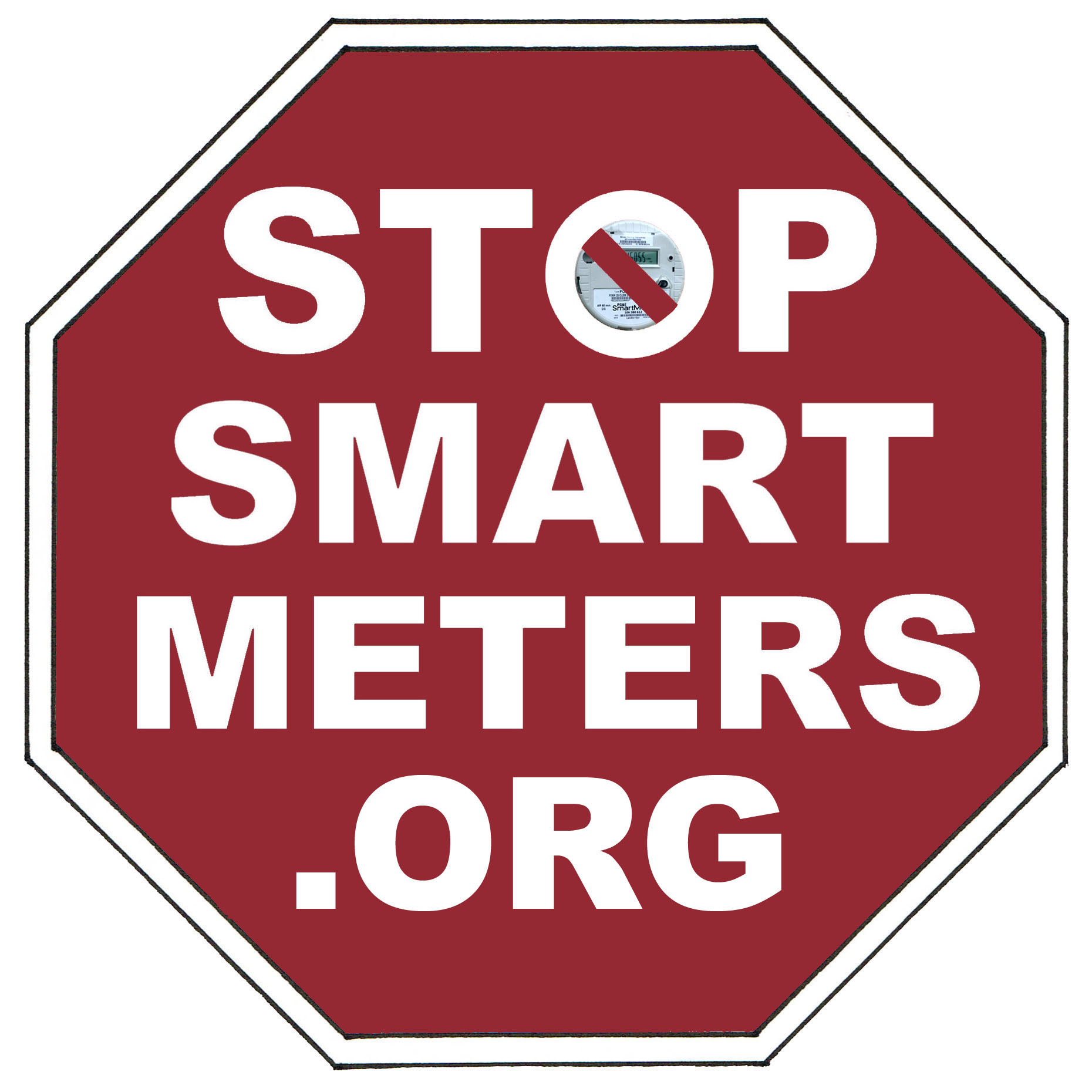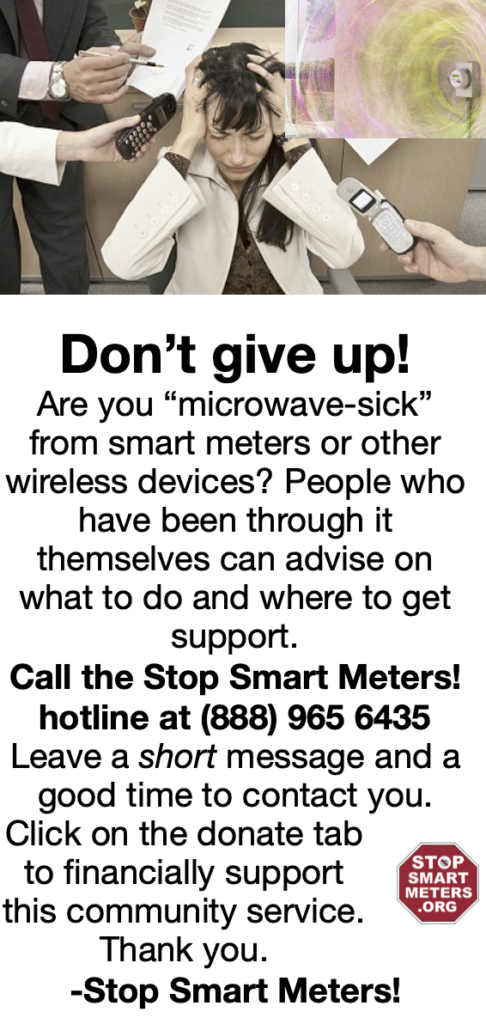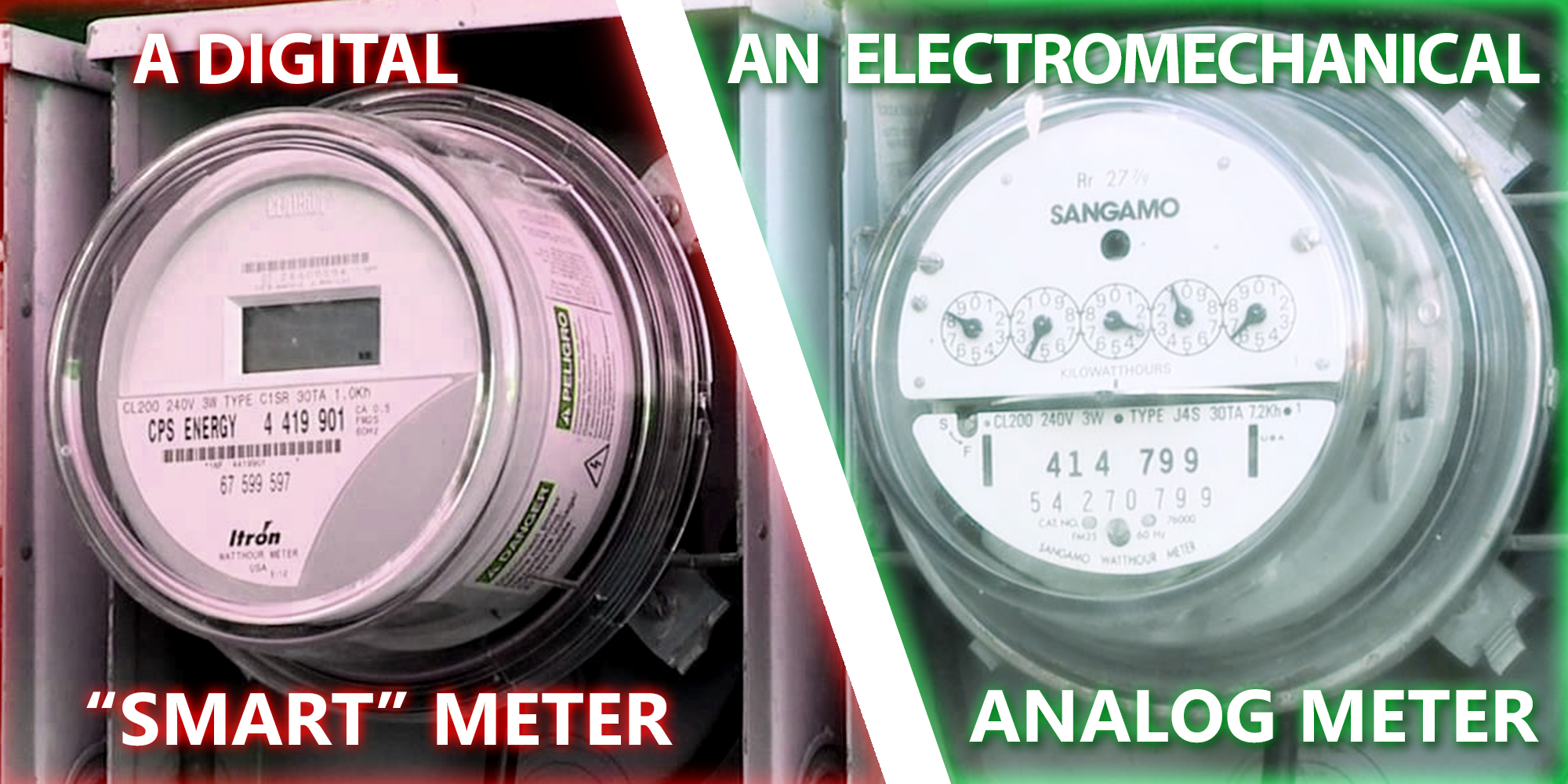This video is notable for a couple of reasons. One is that it confirms what we have been hearing a lot- that even when someone avoids getting a “smart” meter on their home, the smart meters in the neighborhood have been enough to make them sick.
The evidence that ‘smart’ meters contaminate homes and entire neighborhoods with dirty electricity is a big red warning flag that even a meter that has had its microwave transmitter disabled (like PG&E proposes for their “opt out” plan) is still capable of doing serious damage. The capability of the “smart” meter’s switching mode power supply (SMPS) to add high levels of “dirty electricity” onto electrical lines was initially reported by EON in March.
Until we know exactly what is causing the unprecedented numbers of reported health problems in California and elsewhere where the meters are being installed, we must halt any further installations and remove existing wireless meters. If the government can’t act to protect the public, then the public will have to act to protect ourselves.









I am opposed to the new automated revenue meters for many reasons, and I have successfully fought off the installation at my house in Marin.
But as an electrical professional I have to question this dirty power thing.
The switched mode power supply in the new meters is only a power supply to the electronics of the device, not the whole panel.
Dirty power comes from the power grid, not the revenue meters.
Dirty power causes problems for many commercial users, like banks with currency counters, HVAC controls in large buildings and server farms and data centers.
If a customer hires a professional to do a power quality and condition analysis, and they find that the grid is providing dirty power, then they have a claim against the utility provider.
I appreciate that people are against the new revenue meters, as I am too, but it would be better if people did not post things that are not really relevant to this huge problem.
Here is what I predict that will happen in the PG&E service territory next month.
(1) People will be allowed to opt out of a transmitting meter, but will still be forced to have their old reliable analog meters that have been in service for 50 years replaced with a new digital meter.
(2)Those who have already had their old reliable analog meters replaced with a digital one, might have to pay the fee to deactivate the transmitters (PG&E only expects there to be 150,000 customers who don’t want the transmitters).
(3) The people like myself, who still have analog meters will stand up and fight hard to any meter replacement, but if PG&E insists, PG&E will have to disable the transmitter in the meter shop, on their own dime, and not charge us the $230 fee to disable the transmitters.
(4) PG&E will probably weasel the PUC to allow for a new meter reading fee, even though that meter reading has been built into our rates from day one.
The whole automated revenue meter project is all about eliminating manual meter reads, but in some areas, they don’t work. The meters are transmitting for nothing.
PG&E , in their zeal to ramrod the project in some areas, did not do proper research first, they just wanted to make a sale of the new meters.
Now that PG&E finds that they still need meter readers in Marin, they want to come out of their mistake smelling like a rose, and try and collect money from the customers who don’t want the transmitters, to make up for their losses from not testing the system first.
We all know that the shareholders are extremely upset that in Marin the meter readers are still on the payroll.
Like Major Hockstetter from Hogan’s Hero’s said ” HEADS VEEL RROOLL” !
Not sure what kind of electrical professional RediKilowatt is, but Lance Houston is a California Electrical Contractor who disagrees with his claim that “The switched mode power supply in the new meters is only a power supply to the electronics of the device, not the whole panel.”
Here’s a statement Houston wrote titled,
“Unknown: Safety of New Disconnect Switch in Smart Meters:
CPUC Meter Safety Testing Confirmation Needed.
(c) Copyright 2011 Lance Houston
Introduction
There are numerous safety concerns with the new smart meters being installed by PG&E throughout parts of California. The new meters are novel in many ways compared to the old style analog meters that have safely and reliably metered electrical consumption for decades.
One of the novel features in the new meters is the incorporation of an internal disconnect switch that the power company purports safely disconnects/reconnects power to the dwelling it supplies by remote control. This disconnect feature is a new and significant change to the old style analog meters. The safety of the new disconnect feature is in question.
As a California Electrical Contractor, I estimate that a 200 amp disconnect enclosure would be sized roughly 20″x 20″x 6″, several times larger than a smart meter. Concerned about this, I asked other electrical contractors’ opinions about the remote disconnect switch. Like myself, they found it hard to believe a 100, 200, or 400 amp disconnect switch can be crammed into a tiny meter enclosure.
Smart meters are Novel Electrical Devices
The smart meters incorporate multiple new features into a single unit :
1) electronics for actual metering of power consumption,
2) radio frequency transmitter(s) for sending data,
3) radio frequency receiver(s) for receiving data, and
4) an electromagnetic switch for connecting/disconnecting electrical service.
Federal Regulations
Under Federal Regulations testing and safety approval is required for certain products. (Occupational Safety and Health Administration (OSHA) rule 29 CFR 1910). Under this rule, Electrical conductors or equipment are required to be tested and or approved for safety. It does not appear the smart meters have been tested under this federal safety regulation. Smart meters have not been tested and approved under OSHA regulations.
California Regulations
Under California Regulations testing and safety certification is required for meters and meter data. (California Public Utilities Commission (CPUC) D.98-12-080; Permanent Standards For Metering And Meter Data). Under this rule, that was created in part by PG&E, self-certification is done by the meter manufacturer.
The CPUC allows the maker of the meters to do their own testing for safety. Amazingly, “not all components of a meter product are required to be included in the meter product during certification testing.”
Independent third-party testing and review of the end use product is not required. “Trust us the meters are safe.”
Reports of Smart meter Fires
Electrical fires where smart meters have been installed are reported in several California counties, in Alabama, and in countries like New Zealand.Reports detail that the meters themselves can smoke, smolder and catch fire, they can explode, or they can simply create over-current conditions on the electrical circuits. The potential for arcing in the new disconnect feature should be carefully scrutinized. Incidents of fire are reason enough to halt installations.
Test Results Must be made Public
PG&E and the CPUC purport the smart meters are being manufactured in accordance with American National Standards Institute (ANSI) standards. To date, no verification has been made available to the public. The CPUC requires a test report and certification by the manufacturer prior to approval of use. However, to date a comprehensive smart meter test report and filed certification application has not been made available to the public. Because of the novelty of the new smart meters, testing should be by independent third party.
Conclusion
Smart meters are novel devices that have not been tested and approved under OSHA. It is unknown if the field ready (end use product) have been tested or certified for safety. Because the smart meters are novel devices and there are confirmed reports of fires, I believe smart meter installations should be halted immediately. Concerned customers should be allowed to have analog meters re-installed. They have a longstanding safety record.
Questions
Have all the testing requirements in CPUC D.98-12-080; Permanent Standards For Metering And Meter Data been completed?
Does D.98-12-080 and ANSI include testing for all the features of the smart meters?
According to CPUC documents “not all components of a meter product are required to be included in the meter product during certification testing.” Have the smart meters (end use product), undergone testing and certification as a complete field ready unit? If not, why not?
Is there a full load test for the meter disconnect switch?
If a dwelling’s electrical service is rated at 200 amps, the meter has the potential to have a 200 amp load. Are the smart meter disconnects rated for the maximum potential load of the dwelling it serves?
Are the smart meter disconnects tested and certified to safely disconnect/reconnect under full load conditions?
Sizes (amperage) of electrical service to dwellings vary. How many different size meters are there (100amp, 200amp, 400amp etc.) What are the ratings of the meters being installed?
Is there independent third party testing? If not, why not?
Is there independent third party review of the test results? If not, why not?
How does the public know the smart meters (end use product) are safe, what evidence is there?
Resources:
Smart Meter Fires
http://emfsafetynetwork.org/?page_id=1280
OSHA: rule 29 CFR 1910: Electrical conductors or equipment require testing
http://www.osha.gov/dts/otpca/nrtl/prodcatg.html
OSHA: 1910.399 recognized testing laboratories
http://www.osha.gov/pls/oshaweb/owadisp.show_document?p_table=STANDARDS&p_id=9976
OSHA: Sections1910.303 General Requirements and 1910.307 Hazardous (classified) locations
http://www.osha.gov/dts/otpca/nrtl/1910refs.html#1910_303-307
CPUC: D.98-12-080, Decision Regarding Permanent Standards For Metering And Meter Data”
The “switched mode power supply” is a name invented by Motorola but never trademarked. It is just that, a low voltage power supply, converting the A/C line voltage to low volt D/C current to power the electronics in the meter, like the transmitters, receivers, repeaters and data collectors. It is measured in milliamps, very low power.
You are confused, and so is your electrical contractor friend, the remote disconnect switch is not the power supply.
At first, I didn’t know how they remotely disconnected a 200 amp switch, which he is right, ordinarily would be a big relay, like a motor starter or lighting contactor relay.
But I read a post from a person who works in a PG&E meter shop, and I saw an add on the internet advertising Landis+Gyr automated revenue meters.
They both said that the remote disconnect switch is a motorized switch, very old school. It only takes a pulse of 240 volts AC to turn the motor 180 degrees and make or break contact. Sure, there will be an arc if there is a full load on the building, but how often does the utility company ever use a remote disconnecting means ? Not ever at my house in 30 years.
That remote disconnect switch is just more sales hype about how the utility companies can save money, just like all the other hyperbole that they feed the public. But if the new revenue meters are not receiving any signals from the central controller, they cannot remotely disconnect the power.
Tell a friend.
http://www.sfgate.com/cgi-bin/article.cgi?f=%2Fn%2Fa%2F2011%2F07%2F26%2Ffinancial%2Ff131039D84.DTL
Fitch lowers PG&E rating outlook to ‘negative’
Tuesday, July 26, 2011
(07-26) 13:10 PDT New York (AP) —
Fitch Ratings has lowered its rating outlook on PG&E Corp. to “negative” from “stable” citing issues facing the natural gas and electric utility in the wake of the deadly gas pipeline explosion in San Bruno, Calif. last September.
Fitch cites a drop in customer confidence following the San Bruno explosion and the unknown amount of costs and fines the company faces stemming from the blast.
The rating agency says PG&E has come under significant regulatory scrutiny and will face higher operating and capital expenses in order to comply with new pipeline-safety requirements…
Read more: http://www.sfgate.com/cgi-bin/article.cgi?f=/n/a/2011/07/26/financial/f131039D84.DTL#ixzz1UZF2Mcgf
@ Red Kilowatt
HEADS HAF ALREADY RROOLLED” !
Yor post said:
“(1) People will be allowed to opt out of a transmitting meter, but will still be forced to have their old reliable analog meters that have been in service for 50 years replaced with a new digital meter.”
About that legally loaded word “allowed”. This risks becoming an assumption that this entire s/meter house of cards has any legal legitimacy at all.
But does it?
According to internationally universal EMF safety codes the application of the law has changed in Canada as a precedent for elsewhere so that smart meters are illegal effective September 24th., 2010.
The causal link to harm has been proven.
health Canada has ignored the proof.
My understanding from the party bringing it is that a lawsuit involving absence of due diligence and potential criminal negligence seems to be imminent due to continued official endorsement of an illegal device subsequent to the change in the application of the law.
Another suit is already well underway in Oregon re illegality of Wifi which may well have blowback for smart meters as wireless devices. One of the witnesses there, Barry Trower, designed electromagnetic frequency weapons for the military.
My concern about buying into the legitimacy of ANY UTILITY’S assumption of their own right to bring HARM in the face of a change in the law is this:
Anything like a meter which can be deactivated can be reactivated.
Isn’t this as simple as a module swap out later on? Itron’s C1s certainly is convertible, and so is the Openway, as I understand it.
Unlike smart meters, our analog meters are not against the law, are they?
Why not put all effort into hanging on to the permitted and fully legal analog meter which causes the least harm?
I agree. And what I posted was only a prediction, not what I would like to see.
At this point , nobody knows what will happen.
But I do have an update on what is going on in the area that I live (Marin, CA).
Out of the 22 full time meter readers in Marin, half of the staff has been released.
The hiring hall readers were the first to go, earning $36 per hour with no benefits.
The permanent meter readers earn $29 per hour with full benefits.
Now, the meter readers that are left are stretched very thin. They came by and read my card on the street on Sunday. That is a first in the 31 years that I have lived at this address. The meter readers that are left are all working overtime to take up the slack from the corporate plan to eliminate their jobs, and are tired and stressed.
Overtime is paid at time and one half, and not half of the new meters are working yet, so the existing readers are under great pressure for corporate.
The whole plan was supposed to eliminate meter readers, but it is not panning out here in Marin. And we will soon find out if the customers of PG&E will be able to opt out of the automated revenue system, thereby trashing the plan to eliminate meter readers.
There are a few “chosen ones” who work for PG&E in the Marin district that are in charge of getting the data collection receivers communicating with the mesh revenue network. They get a bonus every time that they make a connection with the revenue collection system for a customer. Some of them are not making much money in bonuses, and the investors are furious.
The investors of this privately held utility (PG&E) were also duped. They thought and were promised a profit and savings of $80 million per year for eliminating the meter reading department, and that plan was paid for by the customers who have been charged $220 million per year to fund the program.
It was supposed to be a super sweet deal for the investors, but they got screwed also.
There is no free lunch, if someone tells you that it is free, it’s not !
I live in an old apartment with plaster and lathe walls… the four meters on our building sit on my bedroom wall on the outside… only 6 feet from where I sleep. I’m sick all the time… and I wonder….
My cell phone signal is so bad inside right now that I can’t use my cell phone except in ONE tiny spot in the apartment (very very small apartment)….
and.. I’m sick all of the time, can’t sleep well, CFS symptoms… you name it. Little bit spooked at the moment.
These smart meters pose a risk for the analogue meter, because the wire-less meter
is not compatible with the analogue. This only means that there will be stress on the wiring, which in turn could cause fires or potential damage to homes etc. In that case, who will then be held responsible? We cannot place enough emphasize on the complete assurance on the safety of these “Smart Meters”, and that includes all ill effects, invasion of privacy and not to mention higher electrical bills, which by many have been doubled and even tripled.
This is a lot of food for thought, and requires the involvement of all communities. I still like to think, that there is power in numbers .
Pingback: BWP’s “opt out” meter is a “sham” meter « Burbank ACTION